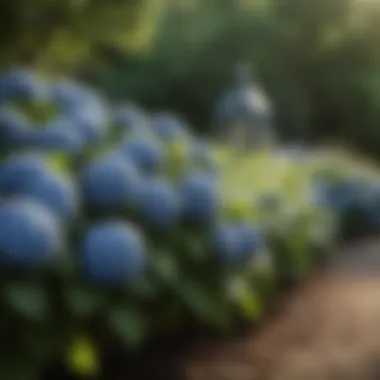Hydrangea Size: Key Factors Affecting Growth


Intro
Hydrangeas, with their stunning blooms and lush foliage, are beloved by gardeners and landscape artists alike. Yet, these plants can vary significantly in size, depending on an array of factors. Whether you’re a seasoned gardener or just looking to add a touch of beauty to your home, understanding what influences hydrangea growth can make a world of difference.
Among the many considerations, the species of hydrangea stands out. Types like Hydrangea macrophylla and Hydrangea paniculata each exhibit distinct growth patterns and preferred environments. Moreover, cultivation methods play a critical role; simple adjustments in care practices, such as pruning and watering, can either help or hinder growth. It's also evident that environmental factors—including sunlight, temperature, and soil conditions—create a landscape where these plants either thrive or merely survive.
This article aims to dive deep into these influences, offering insightful tips and methods for enhancing your hydrangea's size. By gaining an appreciation for these factors, gardeners can not only beautify their spaces but also promote healthy, robust plants.
Stay tuned as we dig into the intricacies of hydrangea growth, exploring how to manipulate these elements to achieve desired results.
Foreword to Hydrangeas and Their Size Variability
Hydrangeas have captured the hearts of gardeners around the globe with their vibrant blooms and lush foliage. Understanding the size variability of these plants is crucial for those looking to incorporate them into their gardens. By knowing the factors that influence their growth, one can tailor their gardening strategies effectively, ensuring the hydrangeas thrive in a way that complements the outdoor space.
The Popularity of Hydrangeas in Gardens
Hydrangeas are often hailed as a favorite among garden enthusiasts, and it’s easy to see why. Their ability to adapt to various climates and soil types makes them appealing to both amateur and seasoned gardeners alike. These plants offer an explosion of colors, ranging from soft pastels to brilliant blues and fiery reds, igniting visual interest in any landscape. Moreover, they serve multiple purposes, be it as border plants, statement pieces, or even wedding bouquets.
Few plants can boast such a broad appeal across different garden styles—be it cottage gardens, modern landscapes, or urban settings. Their versatility allows them to not just grow but flourish regardless of the gardener's skill level. This kind of adaptability contributes significantly to their popularity, driving gardeners to explore the intricacies of their size variability.
A Brief Overview of Hydrangea Species
Hydrangeas come in a medley of species, each with unique characteristics influencing their final size. Understanding these species can help gardeners choose the right type for their spaces. Among the well-known varieties, we have Hydrangea macrophylla, often referred to as the mophead hydrangea, known for its big, globular flower heads, which can reach impressive heights if given proper care.
Another popular type is Hydrangea paniculata. This variety tends to grow taller and is recognized for its conical flower clusters that bloom in summer, often lasting well into fall. On the flipside, there are Hydrangea arborescens, typically growing shorter yet producing bountiful white blooms, such as in the famous variety, ‘Annabelle’.
Every species exhibits a different growth pattern and potential size, influenced by factors like genetics, environment, and care practices.
Choosing the right hydrangea species tailored to individual garden conditions is essential in achieving desired growth outcomes. With each variety contributing its own charm, the key lies in matching these plants with their ideal growing conditions to fully realize their potential.
Key Factors Influencing Hydrangea Size
Understanding the various influences on hydrangea size is crucial for gardeners looking to cultivate these beautiful plants. Hydrangeas are not just a pretty face in the garden; their dimensions can significantly affect the garden's overall aesthetic and health. A well-sized hydrangea can serve as a focal point or an attractive backdrop, while improper care can lead to overgrown or underdeveloped plants. Let’s dive into the factors that play a pivotal role in determining the size of our beloved hydrangeas.
Genetic Influences on Growth
Genetic makeup is one of the primary determinants of hydrangea size. Each species and variety comes equipped with its inherent characteristics. For instance, the popular Mophead hydrangeas typically grow quite large, often reaching heights of up to six feet, while others like the Lacecap variety may remain more modest in size.
- Species Selection: When you're choosing hydrangeas, it’s paramount to consider the type. Selecting a variety that aligns with your space and visual expectations can save a lot of heartache down the line. For example, Panicle hydrangeas tend to be upright and can grow in height, making them suitable for areas with plenty of room.
- Hybrid Varieties: Breeders often create hybrids that may exhibit unique growth patterns, affecting size. Exploring these options is a smart move for homeowners wanting something specific.
The Role of Soil Composition
Soil isn’t just dirt; it’s the foundation of plant health. The right soil composition can work wonders for hydrangeas, while poor soil can stunt their growth significantly.
- Nutrient-Rich Soil: Hydrangeas thrive in nutrient-dense soil. A blend that is rich in organic material can enhance the plant's ability to uptake essential nutrients, promoting robust leaf development and generous blooms.
- pH Levels: Interestingly, hydrangeas are quite sensitive to soil pH, which can influence their size and color. For instance, an acidic soil can give blue hydrangeas, while alkaline conditions can produce pink blooms.
Watering Practices and Their Effects


Water is life, and this holds true for hydrangeas as well. Careful watering helps maintain size and health.
- Consistent Moisture: Providing consistent moisture levels prevents stunted growth or wilting. Hydrangeas have a high water requirement, particularly during hot months.
- Avoiding Overwatering: However, overwatering can lead to root rot, which stifles growth and potentially leads to plant death altogether. Striking a balance is key—consider a drip irrigation system if you tend to forget your watering can.
The Impact of Sunlight and Shade
Where hydrangeas call home greatly impacts their growth. Light conditions play a starring role in determining how large a hydrangea plant will grow.
- Full Sun vs. Partial Shade: Most hydrangeas prefer dappled sunlight. Too much direct sunlight can scorch the leaves and stunt growth, while too much shade can lead to leggy, weak plants. Find that sweet spot!
- Positioning: When planting, observe your garden through different seasons. The positioning of trees and buildings can impact light availability, effectively altering a hydrangea’s growth trajectory.
"Hydrangeas flourish in environments that balance sunlight with shade, embodying the delicate dance between light and life."
In summary, understanding these critical factors—genetics, soil composition, watering practices, and sunlight exposure—can provide gardeners with vital insights into how to cultivate healthy, appropriately sized hydrangeas. By paying attention to these details, garden enthusiasts can enjoy these splendid blooms in their full glory.
Understanding Hydrangea Types in Relation to Size
When diving into the world of hydrangeas, grasping the different types of these plants and how they relate to size is crucial. Each type of hydrangea presents unique characteristics that influence overall growth, maintenance practices, and the aesthetic appeal of your garden. This section shines a light on various hydrangea types and unpacks their individual traits and growth patterns, providing you with the knowledge to make informed decisions for your gardening journey.
Mophead Hydrangeas: Their Characteristics
Mophead hydrangeas are perhaps the most recognizable type, with their globe-like clusters of blooms that can be breathtakingly lush. These plants are often sought after for their large flowers which come in various colors including blue, pink, and white, depending largely on the soil pH. Mopheads are typically heavyweight plants, meaning they require ample space to thrive. They can reach heights of up to six feet, offering a robust growth profile.
To ensure these hydrangeas flourish, proper care is essential. Regular watering, well-drained soil, and a good amount of sunlight will help maintain their size and vibrancy. It's also worth mentioning that their growth can be impacted by pruning techniques, as improper timing can lead to reduced blooming potential.
Lacecap Hydrangeas: A Unique Form
Lacecap hydrangeas stand out with their flat clusters of flowers that resemble a lacey doily. This unique form offers a different aesthetic compared to their mophead counterparts. Generally smaller in size, lacecaps grow to about three to six feet tall and wide but can provide an intricate floral display that benefits from multiple bloom colors.
What makes lacecaps particularly fascinating is how their flower structure impacts their overall size. The outer florets are usually larger, while the inner ones can be quite small, leading to more delicate-looking blossoms that still manage a punch visually. Their growth can be influenced by the same environmental factors that affect mopheads, such as soil conditions and watering habits, making consistency in care key to achieving your desired size and appearance.
Panicle Hydrangeas: Height and Width Profiles
Panicle hydrangeas differ in both size and form, often towering over other types with heights reaching well over eight feet and widths that can expand just as dramatically. These hydrangeas produce cone-shaped flower clusters that evolve in color as they mature, starting from white to a rosy hue in later blooming stages.
One major advantage of panicle hydrangeas is their adaptability. They are well-suited to various soil types and can tolerate full sun, which lends to a more extensive growth capability. Regular pruning after the blooming season can help maintain their size and shape, allowing homeowners to control how these magnificent plants fill their gardens.
Smooth Hydrangeas: A Closer Look
Smooth hydrangeas are often favored for their more compact size and ability to adapt to different environments. Typically growing between three to five feet tall, these plants exhibit large, rounded flower heads that bloom white and transition to pink as summer progresses.
Smooth hydrangeas are particularly resilient, making them an excellent choice for both novice and experienced gardeners. They thrive in a variety of soils and show good drought resistance once established. Their manageable size and growth rate allow them to serve as effective borders or focal points in landscaping, providing flexibility in garden design.
Practical Strategies for Managing Hydrangea Size
Managing the size of hydrangeas isn’t merely a frill for keen gardeners; it’s quite essential for both aesthetic appeal and plant health. Too little attention to size management can lead to bushy, unruly blooms overshadowing their surroundings, or worse, plants that struggle to thrive due to lack of light and air circulation. Therefore, understanding practical strategies is paramount for achieving the desired look while keeping hydrangeas flourishing.
Pruning Techniques and Timing
The art of pruning hydrangeas can be pivotal. Depending on the type of hydrangea you cultivate, the timing and method of pruning can greatly influence size and bloom quality.


Generally, mophead and lacecap varieties should be pruned in the late summer to early fall after they have finished blooming. This prevents cutting off the flower buds that form the following spring. Meanwhile, panicle hydrangeas can be pruned in late winter or early spring, as they produce blooms on new wood.
Some key techniques include:
- Deadheading: Removing spent blooms encourages new growth and can help control the overall size.
- Selective thinning: This involves cutting back some stems entirely to their base, allowing more air and light to reach the remaining foliage.
- Reducing height: If a plant grows more than its designated space permits, don’t hesitate to trim back some of its tallest stems.
"Timing is everything. Prune at the wrong time and you may not see flowers when you expect them."
Utilizing Container Gardening
Container gardening is an often overlooked but effective strategy to manage hydrangea size. By planting hydrangeas in pots, you can restrict their growth and create a more controlled environment. This method allows you to:
- Control Soil Quality: You can easily modify soil composition to meet the specific needs of your plants.
- Adjust Watering Needs: Container plants dry out faster, making it easier to manage their hydration without over-saturating the roots.
- Ease of Relocation: For climate variations, containers can be moved to optimize sunlight exposure or shield from extremities.
Container gardening also means you can choose appropriately sized pots based on the species—larger for those that naturally grow bigger and smaller for those that don't. This adds another layer of versatility to hydrangea management.
Employing Support Structures
Hydrangeas often require support, especially when they’re big and bushy. Using stakes, trellises, or cages can help keep them upright, which can sustain size without leading to sprawled branches that can ruin their symmetry. Some methods to consider include:
- Stakes: Place these near younger plants to guide growth and avoid bending.
- Cages: Designed to allow for hollow frameworks around the plant, allowing blooms to grow without them falling over.
- Trellising: For vining varieties, trellising can support upward growth which can result in a larger footprint without compromising vertical space.
Fertilization for Desired Growth Patterns
Feeding hydrangeas properly can also play a significant role in achieving the right size. Different formulations foster varied outcomes. The use of controlled-release fertilizers or organic compost can spur growth effectively. Necessary considerations include:
- Balanced Nutrients: Choosing a 10-10-10 NPK (nitrogen, phosphorus, potassium) can promote even growth, avoiding over-concentration on one growth aspect.
- Timing: Fertilize in early spring as new growth emerges, and again post-bloom to encourage potential late-season growth.
- Soil Tests: Regularly check soil nutrients to avoid over-fertilization, which can lead to leggy growth rather than compact, healthy plants.
When managed well, sizes can be appropriately kept—with careful thought into how pruning, containment, support, and nutrition can influence your hydrangeas. Keeping plants thriving while fitting into your landscape vision is not just gardening; it’s a balanced dance between creativity and nature.
The Seasonal Influence on Hydrangea Dimensions
Understanding how the seasons impact hydrangea growth is key for gardeners wanting to cultivate lush plants. Each season presents distinct challenges and opportunities concerning hydrangea size, health, and overall vigor. By aligning care practices with seasonal changes, gardeners can maximize their hydrangeas' potential.
Growth Patterns in Spring
Spring marks a new beginning for many hydrangeas. As temperatures rise and daylight lengthens, these plants start to emerge from their winter dormancy. In this season, they typically show a burst of growth.
- Buds Forming: During early spring, fresh buds will start to develop on the stems. This is the time to observe how well the plants are getting sunlight and moisture. If hydrangeas are stunted, it might be due too little sunlight or poor drainage.
- Fertilizing: It's crucial to apply fertilizer as the buds begin to swell. A balanced fertilizer will encourage strong growth and an increase in flowers later in the season. Look for organic options that enhance soil health without harming the environment.
- Watering Needs: Spring rainfall usually provides ample moisture; however, keep an eye on the soil. If it dries up quickly, additional watering may be necessary.
Summer Care Regimens
When summer rolls around, the heat can be a double-edged sword. Hydrangeas can thrive but may also face stress if not cared for properly.
- Regular Watering: Hydrangeas are quite thirsty during this period. A deep watering regime is essential, ensuring moisture reaches the roots. This can be done ideally in the early morning or late afternoon to prevent evaporation.
- Mulching: Adding a layer of mulch can help retain moisture, suppress weeds, and provide a stable temperature for the root system. Organic mulch, such as pine bark or shredded leaves, can also enrich the soil as it breaks down.
- Monitoring Flower Development: Summer is when the blooms start to come in. It’s important to monitor the flowers, as heat can cause wilting or fading. Light pruning of wilted flowers can encourage more blossoms.
Autumn Preparations for Size Management


As autumn approaches, it's time to prepare hydrangeas for the colder months. The fall is a turning point for growth and size regulation.
- Final Pruning: After the last blooms fade, consider pruning. Depending on the species, cut back dead or overly long stems. This promotes healthier growth next spring and can help manage their size.
- Soil Nutrition: Autumn is a good time to enrich the soil with compost. This helps improve structure and nutrient availability for the next growing season.
- Protection against Frost: In many regions, early frost can harm hydrangeas. Use burlap or frost cloths to protect particularly sensitive varieties.
Winter Maintenance Practices
Winter can be a harsh time for hydrangeas, but some specific practices can help ensure they come back strong in spring.
- Reducing Watering: As hydrangeas enter dormancy, their water needs drastically go down. Over-watering during this period can lead to root rot. Take care to only water if you notice particularly dry spells.
- Mulching for Insulation: A fresh layer of mulch can help insulate the roots, keeping them warm during colder temperatures. This acts as a protective barrier against freezing and thawing cycles that can damage the roots.
- Limit Interaction: It’s also important to limit interaction with your hydrangeas during winter months. Let them rest undisturbed to conserve energy.
"Planning for growth changes with the seasons can create a more rewarding gardening experience and healthier hydrangeas."
With every season bringing new tasks and considerations, it’s essential to have an eye on how these phases influence hydrangea size. Gardeners willing to adapt their strategies seasonally are likely to see vibrant, thriving plants throughout the year.
Common Challenges in Achieving Desired Size
Managing the size of hydrangeas can often feel like navigating a maze. The unpredictability inherent in gardening, coupled with the specific needs of hydrangea varieties, creates a landscape fraught with challenges. Understanding these hurdles is essential not only for achieving aesthetic goals in your garden but also for ensuring the health and vitality of your plants. The sum of these challenges—pests, diseases, environmental factors, and the necessity for consistent care—shapes the success or failure of reaching your desired hydrangea size.
Pests and Diseases Impacting Growth
Hydrangeas, like any other garden plants, are susceptible to a variety of pests and diseases that can hinder their growth. Common culprits include aphids, spider mites, and powdery mildew. Aphids feed on the sap of hydrangeas, weakening the plant and leading to stunted growth. Spider mites thrive in dry conditions, while powdery mildew flourishes in humid environments.
To combat these issues, gardeners must keep a keen eye on their plants. Employing organic solutions such as neem oil or insecticidal soap can support plant health without introducing harsh chemicals into the environment. Regular inspections can go a long way in identifying problems before they spiral out of control.
"An ounce of prevention is worth a pound of cure." This wisdom rings especially true when managing pests and diseases, emphasizing the value of proactive care.
Environmental Stressors and Their Effects
Hydrangeas are particularly sensitive to their surroundings. Several environmental factors can cause stress, impacting their growth and overall size. Factors such as extreme temperatures, poor soil drainage, and inconsistent watering practices create conditions unfavorable for development.
For instance, hydrangeas planted in overly compacted or poorly draining soil are at risk of root rot. Similarly, sudden temperature spikes or drops may trigger distress signals in these plants, leading them to conserve energy rather than allocate it towards growth. Recognizing and mitigating these stressors is crucial. This could involve improving soil drainage, mulching to retain moisture, or relocating hydrangeas to a more suitable environment, thus promoting steady growth and health.
The Importance of Consistency in Care
The success of growing hydrangeas akin to teaching a puppy new tricks lies in the consistency of care. Regular watering, feeding, and attention to pruning can greatly influence the size and vibrancy of hydrangeas. Inconsistent care often sends mixed signals to these plants, leading to erratic growth patterns. For example, plants that receive plenty of water one week and are neglected the next will struggle to establish a healthy growth routine.
Consistency allows hydrangeas to develop a robust root system and a uniform growth pattern. This can be achieved by setting up a regular maintenance schedule. Feeding with a balanced fertilizer during the growing season and pruning according to species requirements ensures that hydrangeas are well-equipped to thrive. By treating these plants with the regularity they crave, homeowners can cultivate a flourishing hydrangea garden that meets their size expectations.
Closure: Synthesizing Hydrangea Size Insights
Understanding the many factors that affect hydrangea size is crucial for anyone keen on cultivating these stunning plants. This article delves into the genetics, environmental conditions, and care practices that together shape the growth of hydrangeas. By bringing these elements to light, we aim to guide growers toward achieving their desired aesthetic and health for these beloved garden shrubs. Each phase of hydrangea development—from initial planting to seasonal care—plays a significant role in whether these species reach their full potential or struggle to thrive.
"A well cared-for hydrangea can transform any garden, but only if the grower understands its unique needs."
A major takeaway is that there isn't a one-size-fits-all approach to hydrangea cultivation. For instance, modifications in soil composition can lead to drastically different outcomes in size. Similarly, water and sunlight exposure calibrate how lush and expansive these plants may grow. Proper care often involves a delicate balance of these factors, emphasizing the need for ongoing education about specific species. Thus, taking the time to grasp these interconnected elements can directly result in more vibrant, robust plants.
The Bigger Picture of Hydrangea Cultivation
In assessing the broader context of hydrangea cultivation, it becomes evident that understanding size influences various aspects of gardening. Homeowners and landscaping professionals alike should consider factors such as spacing between plants and their individual sunlight and watering needs. A garden filled with well-proportioned hydrangeas not only looks aesthetically pleasing but also enhances the health of the entire plant community.
Moreover, as gardeners become more aware of the parameters that affect size, they can better plan their garden layouts. It’s not just about planting pretty flowers; it’s about creating a thriving ecosystem that supports them. For instance, arranging shorter varieties in front of taller ones allows for better light distribution and air circulation, further enhancing the overall display.
Future Considerations for Enthusiasts
For those enthusiastic about hydrangeas, the future beckons with both challenges and opportunities. As climate change becomes an undeniable factor, it’s important to pay attention to altering environmental impacts, such as changes in rainfall patterns and temperature shifts. Gardeners should remain adaptable, ready to modify their care routines to respond to these variations effectively.
Furthermore, research and innovation in gardening techniques continue to evolve, offering promising advancements for hydrangea cultivation. Utilizing soil amendments or experimenting with hybrid species could lead to size alterations that align better with contemporary garden designs. Joining gardening communities, whether in person or online through platforms like reddit.com or facebook.com, can provide vital knowledge-sharing avenues.
Thus, cultivating hydrangeas isn't merely a hobby; it's a lifelong journey filled with learning and adaptation. Enthusiasts should embrace this fluidity and continue to explore how best to nurture these beautiful plants into their expected stature.















